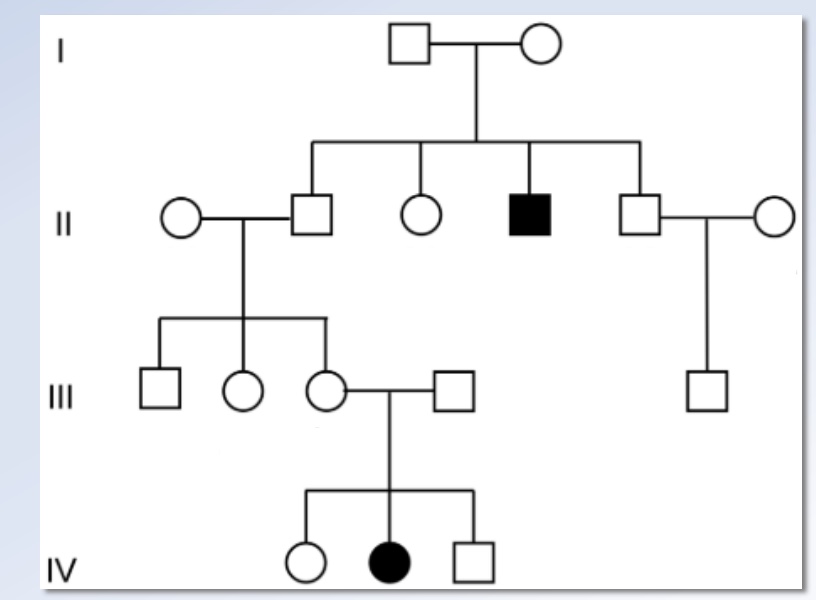CHAPTER 2-3:Pedigrees; Independent Assortment of Genes; Probability; Chi-square
1/9
There's no tags or description
Looks like no tags are added yet.
Name | Mastery | Learn | Test | Matching | Spaced |
|---|
No study sessions yet.
10 Terms
What is a pedigree and what is it used for?
A pedigree is a branched diagram that traces family history for a trait. It helps identify the inheritance pattern (mainly monogenic conditions) and can predict risks in future generations.edigrees require well-documented family history over at least 2–3 generations
How are pedigrees read and what symbols are used?
Pedigrees track traits across generations using Mendelian ratios to find inheritance patterns.
Generations: Roman numerals (I, II, III …)
Individuals: Arabic numbers (1, 2, 3 …); e.g., proband = II-2
Symbols:
♂ unaffected = clear square
♂ affected = filled square
♂ heterozygous = half-filled/marked square (~)
♀ unaffected = clear circle
♀ affected = filled circle
♀ heterozygous = half-filled/marked circle (~)
Adopted = [ ]
Deceased = symbol crossed out
Gender neutral = diamond ♦
![<p>Pedigrees track traits across generations using <strong>Mendelian ratios</strong> to find inheritance patterns.</p><ul><li><p><strong>Generations:</strong> Roman numerals (I, II, III …)</p></li><li><p><strong>Individuals:</strong> Arabic numbers (1, 2, 3 …); e.g., proband = II-2</p></li><li><p><strong>Symbols:</strong></p><ul><li><p><span data-name="male" data-type="emoji">♂</span> unaffected = clear square</p></li><li><p><span data-name="male" data-type="emoji">♂</span> affected = filled square</p></li><li><p><span data-name="male" data-type="emoji">♂</span> heterozygous = half-filled/marked square (~)</p></li><li><p><span data-name="female" data-type="emoji">♀</span> unaffected = clear circle</p></li><li><p><span data-name="female" data-type="emoji">♀</span> affected = filled circle</p></li><li><p><span data-name="female" data-type="emoji">♀</span> heterozygous = half-filled/marked circle (~)</p></li><li><p>Adopted = [ ]</p></li><li><p>Deceased = symbol crossed out</p></li><li><p>Gender neutral = diamond <span data-name="diamonds" data-type="emoji">♦</span></p></li></ul></li></ul><p></p>](https://knowt-user-attachments.s3.amazonaws.com/f4cfba7c-e600-41b5-b27f-f84d03143c19.png)
If black fill indicates a disorder, what does it mean if the trait appears in generation II but not in generation I?
This pattern shows a recessive inheritance. The disorder skipped generation I because the great-grandparents were carriers, and it only appeared in generation II when both passed on the recessive allele.

What laws did Mendel discover from monohybrid and dihybrid crosses, and what were the results of his dihybrid experiment? (define everything)
Law of Segregation: traits have two alleles that separate during meiosis.
Law of Independent Assortment: traits assort independently when studying two traits at once.
Parental cross: RRyy (round green) × rryy (wrinkled yellow).
F1: all RrYy (round yellow) → dominance = round (R) and yellow (Y).
F2 from F1 self-cross → 9:3:3:1 ratio:
9/16 round yellow
3/16 round green
3/16 wrinkled yellow
1/16 wrinkled green
How do you calculate the observed ratio in a dihybrid cross?
Order phenotypes from most dominant → most recessive.
Take the smallest number of offspring and divide it by itself (=1).
Divide all other numbers by the same value.
Example:
315/32 = 9.8
108/32 = 3.4
101/32 = 3.2
32/32 = 1
Observed ratio ≈ 9.8 : 3.4 : 3.2 : 1
(Expected Mendelian ratio = 9 : 3 : 3 : 1)
What does the Law of Independent Assortment show?
The Law of Independent Assortment shows that:
different traits (i.e. genes) are inherited independently of one another if they are on different chromosomes, (or very far apart from one another on the same large chromosome).
How do maternal and paternal alleles assort?
All maternal & all paternal alleles do not end up in the same gamete; rather maternal and paternal pairs can assort independently of each other (assuming there is no gene linkage) to create chromosomes with new allelic combinations in gametes.
Recombination of alleles during crossing-over plus independent assortment results in novel phenotypes not seen in either parent.
What are the outcomes of a dihybrid cross?
When starting with two purebred parents, a dihybrid cross exhibits:
→ F1 heterozygous genotypes (AaBb) showing both dominant traits (‘AB’)
→ F2s genotypes after crossing the F1 heterozygotes with a:
9:3:3:1 phenotypic ratio
and a 1:2:1:2:4:2:1:2:1 genotypic ratio
→ Test cross of F1 heterozygote would give an F2 1:1:1:1 ratio (test cross = AaBb X aabb)
What is the chi-sq analysis and formula?
The chi-square formula tests the ‘goodness of fit’ of data to a null hypothesis.
Formula: χ² = Σ ((observed − expected)² / expected)
Use:
Compare observed data to expected data based on a null hypothesis.
Higher χ² → larger difference between observed and expected.
Use degrees of freedom and a chi-square table to determine statistical significance.
What does a chi-square (X²) sheet look like for a dihybrid cross? How do you interpret a chi-square (X²) value?
Look at a X² chart to locate the p value for your X² number.
If p < 0.05, reject the notion of independent assortment.
If p > 0.05, accept that Mendelian inheritance took place.
